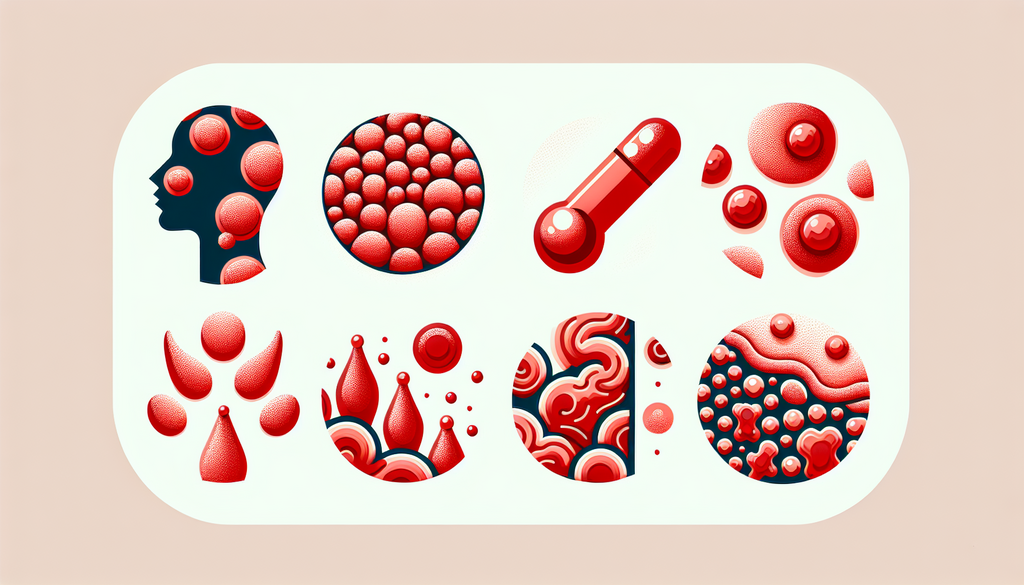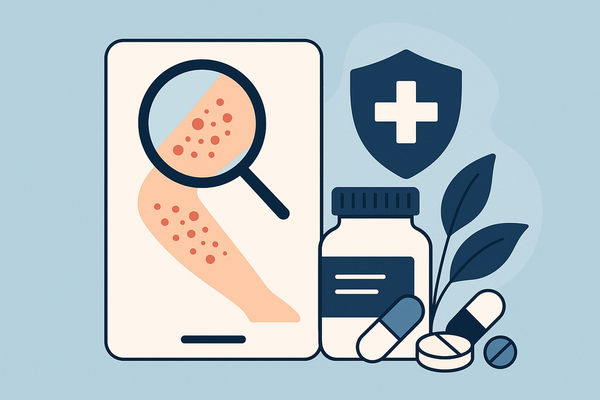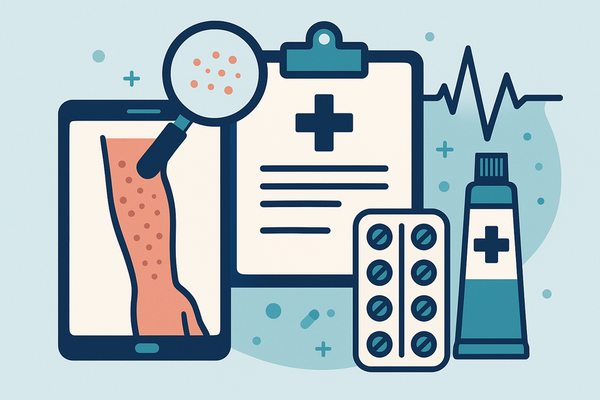Red Itchy Rash: How to Identify and Treat Common Skin Rashes
Learn how to identify and treat red itchy rashes, including bumpy skin rash, small blister rash, scaly patches, and circular ring rashes for better skin health.

Estimated reading time: 8 minutes
Key Takeaways
- Pattern recognition leads to faster relief by identifying rash types early.
- Differentiate between bumpy, blister, scaly, and ring-shaped rashes for targeted care.
- Know sudden rash causes—like allergies and infections—to prevent repeat episodes.
- Use a simple diagnostic checklist to spot red flags and decide when to seek help.
- Early treatment—from home remedies to medical intervention—improves outcomes.
Table of Contents
- Section 1: Overview of Common Skin Rashes
- Section 2: Detailed Identification of Each Rash Type
- Section 3: Understanding Sudden Skin Rash Causes
- Section 4: Diagnostic Tips and When to Seek Help
- Conclusion and Takeaway
- FAQ
Section 1: Overview of Common Skin Rashes
Red Itchy Rash Overview
A red itchy rash is any area of skin that becomes inflamed, red, and itchy. Recognizing whether you’re dealing with a bumpy skin rash, a small blister rash, a scaly patch on skin, or a circular ring rash is key to choosing the right care. In some cases, you might notice this rash on specific areas like your rash on your neck, back or arm.
Common presentations include:
- Bumpy skin rash
- Small blister rash
- Scaly patch on skin
- Circular ring rash
Why it matters: spotting these variations helps you narrow down causes, pick effective home treatments, or know when to consult a healthcare professional.
Sources:
healthline.com/health/rashes
my.clevelandclinic.org/health/diseases/17413-rashes-red-skin
Section 2: Detailed Identification of Each Rash Type
2.1 Red Itchy Rash Details
Appearance and symptoms
- Flat or raised red patches, often merging into larger areas
- Itching ranges from mild to intense, sometimes burning or stinging
Common triggers
- Allergic reactions/contact dermatitis (soaps, metals, plants)
- Chemical or irritant exposure (detergents, solvents)
- Viral or bacterial infections (measles, strep)
- Autoimmune conditions (lupus, psoriasis)
- Chronic eczema flare-ups
Underlying concerns
- Persistent or spreading rashes may signal infection or systemic disease
- Seek medical care if the rash covers large areas, doesn’t improve, or you develop fever
Sources:
my.clevelandclinic.org/health/diseases/17413-rashes-red-skin
webmd.com/skin-problems-and-treatments/common-rashes
2.2 Bumpy Skin Rash Identification
Identification
- Raised bumps, welts, or lumps; uneven texture to the touch
- May appear singly or in clusters; color varies from pink to bright red
Associated conditions
- Hives (urticaria): sudden, itchy welts that come and go
- Scabies: tiny burrow tracks with intense night itch
- Allergic reactions: insect bites, food allergies, drug reactions
Other notes
- Swelling often accompanies allergic or infectious causes
- Use anti-itch creams, cool compresses, and avoid scratching to prevent breaks
Sources:
my.clevelandclinic.org/health/diseases/17413-rashes-red-skin
uchealth.org/diseases-conditions/skin-rashes
2.3 Small Blister Rash Features
Appearance
- Small fluid-filled blisters (vesicles) on an inflamed base
- Blisters may break open, ooze, and form crusts
Common causes
- Viral: chickenpox, shingles (herpes zoster)
- Bacterial: impetigo, secondarily infected eczema
- Allergic contact dermatitis: reaction to plants (poison ivy), metals
Key differentiator
- Presence of clear or yellow fluid sets these apart from flat or scaly lesions
Treatment pointers
- Keep area clean and dry; apply antiseptic ointment as needed
- Seek antiviral or antibiotic therapy for widespread or painful cases
Sources:
healthline.com/health/rashes
uchealth.org/diseases-conditions/skin-rashes
2.4 Scaly Patch on Skin Characteristics
Appearance
- Dry, flaky, rough patches; skin often thickens or peels
- Color can range from pink to silver-white scales
Linked conditions
- Eczema (atopic dermatitis): red, itchy, chronic; often in skin folds
- Psoriasis: well-defined plaques, often on elbows, knees, scalp
Symptoms
- Itching, burning, discomfort, fissures that can bleed
- May worsen with stress, weather changes, or irritants
Care tips
- Use gentle moisturizers, avoid hot water, consider topical steroids under guidance
Sources:
webmd.com/skin-problems-and-treatments/common-rashes
uchealth.org/diseases-conditions/skin-rashes
2.5 Circular Ring Rash Patterns
Pattern and look
- Annular (ring-shaped) lesion with a clearer center and raised/scaly border
- Edges often more inflamed than the center
Typical associations
- Ringworm: fungal infection, itchy, well-defined red rings
- Granuloma annulare: firm, non-scaly rings, often on hands/feet
Key points
- Fungal infections glow under a Wood’s lamp; central clearing is common
- Antifungal creams or tablets clear ringworm; granuloma annulare may resolve on its own
Sources:
healthline.com/health/rashes
uchealth.org/diseases-conditions/skin-rashes
Section 3: Understanding Sudden Skin Rash Causes
Sudden Skin Rash Causes Explained
Sudden skin rash causes are triggers behind a rash that appears quickly, sometimes within minutes or hours. Recognizing these helps you avoid repeat episodes.
- Allergic reactions
Foods (nuts, shellfish), medications (antibiotics), plants (poison ivy)
Contact dermatitis from chemicals, fragrances, metals - Environmental factors
Heat rash (miliaria) from blocked sweat ducts
Sweat-induced irritation, new laundry detergents, chlorine - Infections
Viral: chickenpox, shingles, measles
Bacterial: impetigo, staph infections
Fungal: ringworm, yeast infections - Autoimmune disorders
Lupus, dermatomyositis, lichen planus can flare with sun or stress
Prevention and management
- Patch-test new products on a small skin area
- Wear breathable fabrics in hot weather
- Seek prompt treatment for infections to stop spread
Sources:
healthline.com/health/rashes
my.clevelandclinic.org/health/diseases/17413-rashes-red-skin
medicalnewstoday.com/articles/317999
uchealth.org/diseases-conditions/skin-rashes
Section 4: Diagnostic Tips and When to Seek Help
Diagnostic Tips for Red Itchy Rashes
Observation checklist
- Color: pink, red, purple, or brown
- Texture: smooth, bumpy, scaly, or vesicular
- Shape: circular, irregular, linear, or grouped
- Blisters/crusts: present or absent
Self-assessment points
- Speed of spread: hours, days, or slowly over weeks
- Systemic signs: fever, headache, muscle aches
- Infection clues: pus, warmth, swelling, lymph node enlargement
Red flags
- Severe pain, rapid spread over large body areas
- Trouble breathing, facial swelling, or chest tightness
- Persistent, recurrent, or unexplained rashes
- Signs of infection or systemic illness
When to seek help
- Immediate medical care for breathing issues or widespread hives
- Dermatologist visit for chronic or unclear rashes
For a quick, AI-powered skin analysis to help clarify rash patterns, try Rash Detector for an instant overview.

Conclusion and Takeaway
Recognizing a red itchy rash—and distinguishing between a bumpy skin rash, a small blister rash, a scaly patch, or a circular ring rash—helps you find relief and avoid complications. Proper pattern recognition guides early treatment, whether that means soothing lotions, antifungal creams, or a doctor’s visit. For sudden rash causes, knowing your triggers can prevent repeat episodes. Always consult reliable sources or healthcare professionals for rashes that are severe, persistent, or worrying. Early identification and action lead to healthier skin and faster recovery.
Stay informed, protect your skin, and seek help when needed.
FAQ
- What causes a circular ring rash? Circular ring rashes often arise from fungal infections like ringworm or inflammatory conditions such as granuloma annulare. Key clues include a clear center and raised, scaly border.
- How can I identify a scaly patch? Scaly patches appear as dry, flaky areas that may thicken or peel. They often come with itchiness or burning and are common in eczema or psoriasis.
- When should I see a doctor for a red rash? Seek medical attention if the rash rapidly spreads, covers large areas, is accompanied by fever, or you experience breathing difficulties or severe pain.
- What home treatments help a small blister rash? Keep the area clean and dry, apply antiseptic ointment, and avoid scratching. For widespread or painful cases, consult a professional for antiviral or antibiotic therapy.





